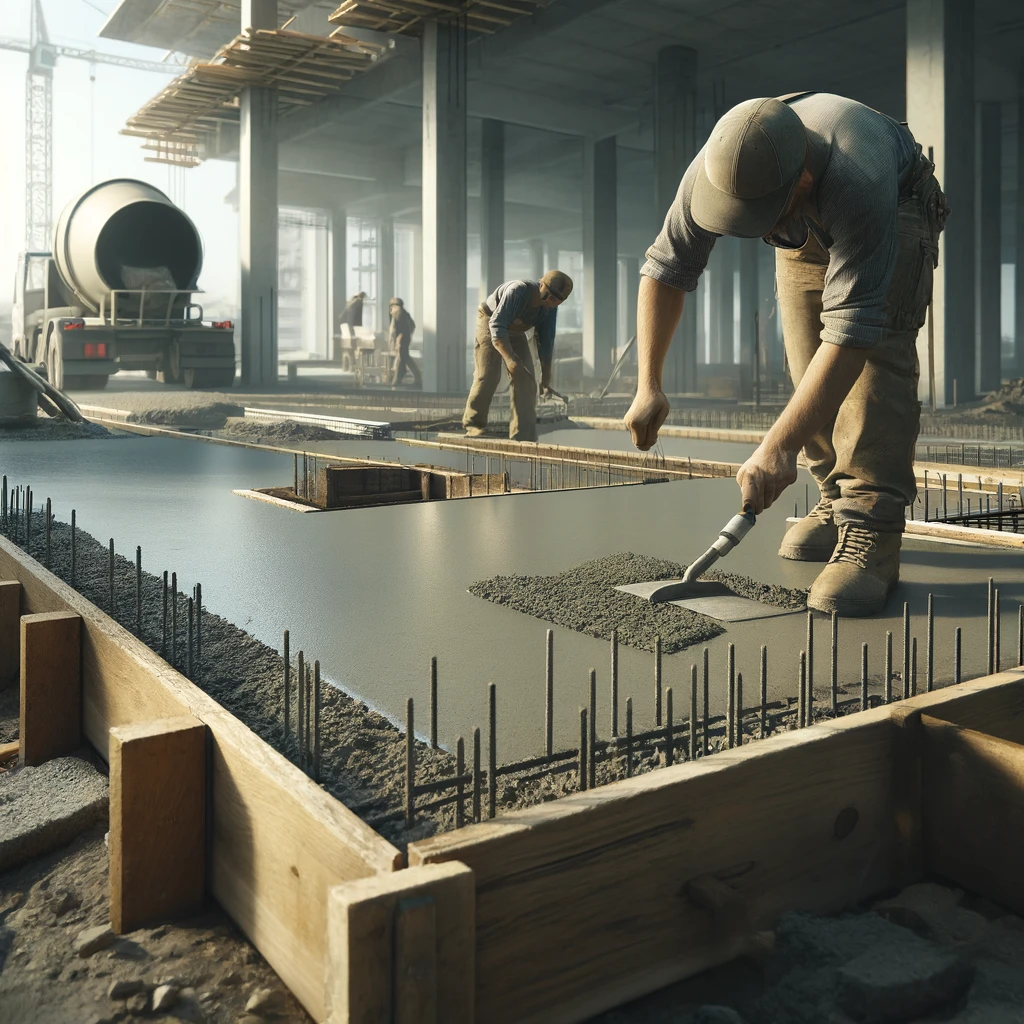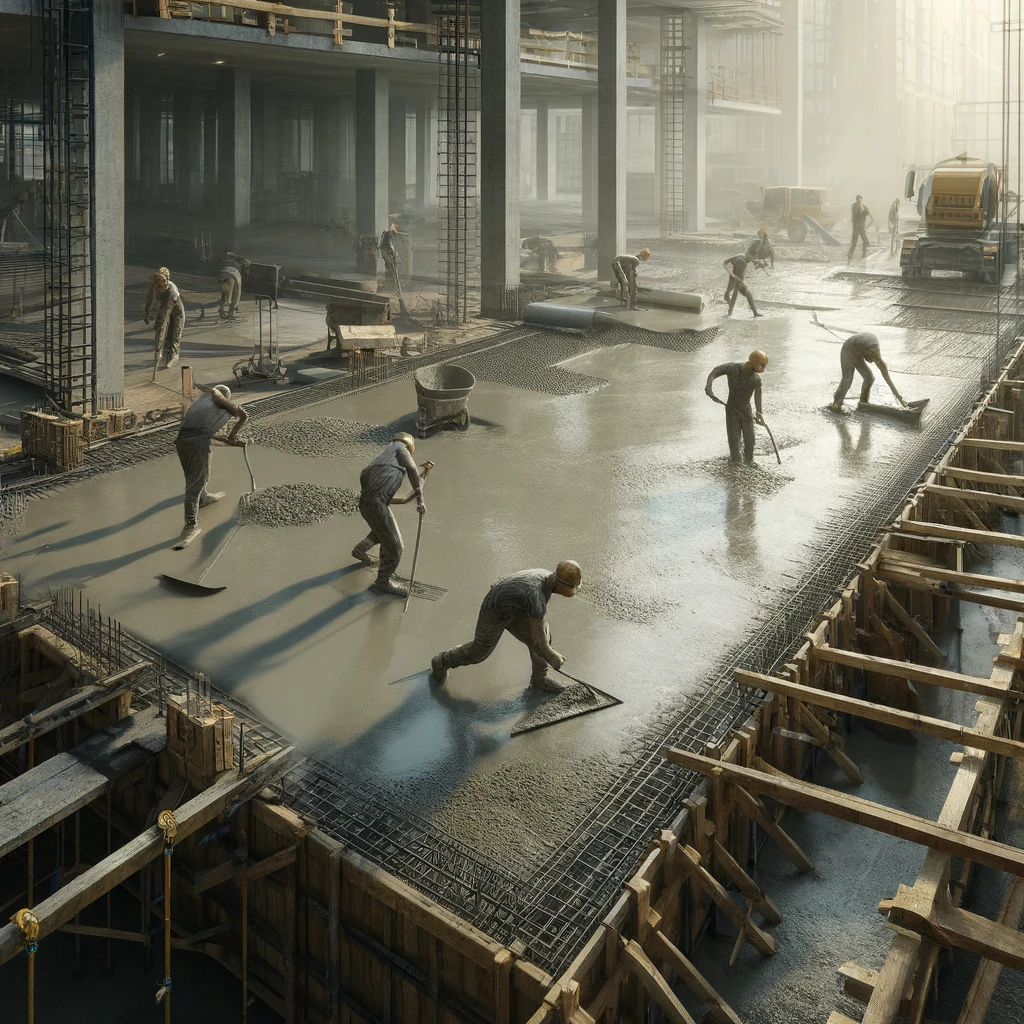Flatwork Concrete: An Introduction
Writing about the mystery of flatwork concrete may not sound like your typical adventure.
Yet, here we are.
And understanding this common construction term can enhance both industry knowledge and home projects.
This approachable guide aims to strip down the complexity associated with flatwork concrete, offering concise explanations and valuable insights.

Table of Contents
Common Mistakes to Avoid When Working with Flatwork Concrete
At first glance, working with flatwork concrete may appear as simple as pouring and smoothing, but there are a handful of pitfalls that could put your project at risk.
Understanding these common mistakes can help ensure a successful, durable and aesthetically appealing concrete installation.
Here are seven common mistakes to avoid when dealing with flatwork concrete.
1. Failing to Prep the Site Properly
Proper site preparation is vital for a smooth and stable concrete installation. Any failure in this area could lead to uneven surfaces, cracks or even complete failure of the project.
2. Poor Mix Design
Concrete is a mix of cement, water, and aggregates. The proportions of these ingredients need to be just right to ensure strength and durability. Too much or too little water, for example, can weaken the concrete.
3. Forgetting to Use Reinforcement
Reinforcements like steel bars or wire meshes are necessary for adding structural strength to concrete flatwork. Even simple projects like driveways or patios can benefit from reinforcement to prevent cracking.
4. Improper Placement and Finishing Techniques
Smooth and level surfaces are part of the beauty of flatwork concrete. But achieving these results requires careful placement, troweling, and smoothing of the concrete.
5. Ignoring Curing
Curing is a critical step that ensures the concrete develops adequate strength. Ignoring this process or rushing it can lead to surface defects and weak concrete.
6. Inadequate Slope Consideration
Flatwork might sound like it should be completely level, but to prevent water pooling, it’s critical to include a slight slope for efficient drainage.
7. Neglecting Jointing
Concrete contracts as it dries. Without control joints at regular intervals, this can lead to random, unsightly cracks in your finished flatwork.
Overview of Concrete Flatwork Errors
| Mistake | Result | Best Practice |
|---|---|---|
| Poor site preparation | Uneven surfaces and cracks | Prepare site thoroughly before pouring |
| Bad mix design | Weaker concrete | Follow manufacturer recommendations for the mix |
| No reinforcements | Strength issues and cracking | Use appropriate reinforcement based on design |
| Improper placement and finish | Non-level surfaces | Use proper techniques for concrete placement and finishing |
| Ignoring curing process | Surface defects and weaker concrete | Never rush or skip the curing process |
| Inadequate slope | Water pooling | Consider a slight slope during design and installation |
| Neglecting jointing | Random cracks | Include control joints at regular intervals |
Factors That Increase the Cost of Flatwork Concrete Projects
Key Factors Influencing Costs in Flatwork Concrete Projects
Understanding these factors can help in budgeting and managing your next flatwork concrete project more effectively.
1. Material Costs
The shirttop of the cost iceberg is the concrete itself. Costs here can vary widely based on the grade and quality of the concrete mix. Additives to the mix can also influence prices.
2. Labor Expenses
Labor is the second major factor that can impact the price of flatwork concrete projects. The complexity of the job, local labor costs, and the experience level of the workers all contribute to labor expenses.
3. Site Prep Requirements
If your project requires significant site prep work (like tree removal or soil stabilization), these tasks can notably increase the overall project cost.
4. Finishing and Decorative Options
Choosing to add a decorative finish or enhancements, such as stamped patterns or staining, can increase costs considerably.
5. Equipment Rental
For larger projects, renting or purchasing additional equipment may be necessary. The cost of this can also add a significant amount to your project’s budget.
Breakdown of Potential Extra Costs in Flatwork Concrete Projects
For a practical perspective, let’s breakdown these costs.
| Factor | Potential Extra Cost |
|---|---|
| High-quality concrete mix | $5-$8 per square foot |
| Professional labor | $3-$18 per square foot |
| Site prep work | $1-$5 per square foot |
| Decorative finish | $2-$12 per square foot |
| Equipment rental | $60-$2,500, depending on equipment |
Keep in mind these are just estimates, and actual costs can vary widely depending on local material and labor rates, and the specific requirements of your project. It’s always best to get multiple quotes before starting a flatwork concrete project 1.
Knowing these factors will better equip you in planning your projects and negotiating contracts. Be sure to keep these elements in mind while estimating your flatwork concrete project costs. For professional advice, always reach out to local contractors or concrete specialists.

Flatwork Concrete Cost Per Square Foot
When venturing into a construction project, understanding the cost of flatwork concrete per square foot is fundamental for effective budgeting and project management.
Factors Affecting the Cost of Flatwork Concrete
Multiple factors come into play when determining the cost of flatwork concrete. These comprise:
- Type of concrete used
- Complexity of the work
- Geographical location
- Local labor costs
- Size of the project
Impact of Geographic Location
Geography plays a significant role in the pricing of concrete flatwork. Costs can vary dramatically from one region to another due to varying labor costs, availability of materials, and local market dynamics.
The Complexity of the job
The more complex the project—meaning more intricate designs or patterns—the higher the cost per square foot. Complexity often requires additional labor or superior skills, which subsequently influences the total cost.
Size of the Project
The rule of thumb is that larger projects often enjoy a lower cost per square foot. This is due to the economy of scale, which allows for increased efficiency and cost reduction.
Average Flatwork Concrete Cost
The average cost of flatwork concrete typically lies between $3 to $10 per square foot, although this can scale up to $15 to $25 per square foot for more elaborate and complex jobs [Source](https://homeguide.com/costs/concrete-driveway-cost). However, remember that this is an average, and actual prices will depend on a variety of factors previously discussed.
| Job Complexity | Average Cost Per Square Foot |
|---|---|
| Basic Flatwork | $3-$10 |
| Complex Flatwork | $15-$25 |
Cost Conclusion
While it is important to keep the cost per square foot in mind for budgeting purposes, it’s equally crucial to consider other factors such as the complexity of the job, local labor costs, and the size of the project to arrive at the most accurate price estimation.
Always consider getting local estimates to ensure you have the most accurate information for your specific project.
Note: This article serves as a guide, prices heavily depend on individual project needs and can vary based on different factors discussed.
Final Notes on Flatwork Concrete
In light of our discussion on the common slipups encountered in handling flatwork concrete, it’s evident that details matter immensely in ensuring project success.
From the initial step of proper site preparation to the significant consideration of slope and jointing, each stage demands due attention and care.
Failure to meticulously follow these steps can lead to catastrophic errors such as surface defects, uneven surfaces, and random cracks.
In our experience, these common mistakes can be significantly reduced or totally eliminated with a thorough understanding of proper flatwork concrete procedures.
Furthermore, consulting with a professional can provide valuable insight and guidance tailored specifically to your project’s unique requirements.
Remember that with cautious application of these best practices, you are ensuring durability, functionality, and aesthetic appeal for your concrete flatwork project.






